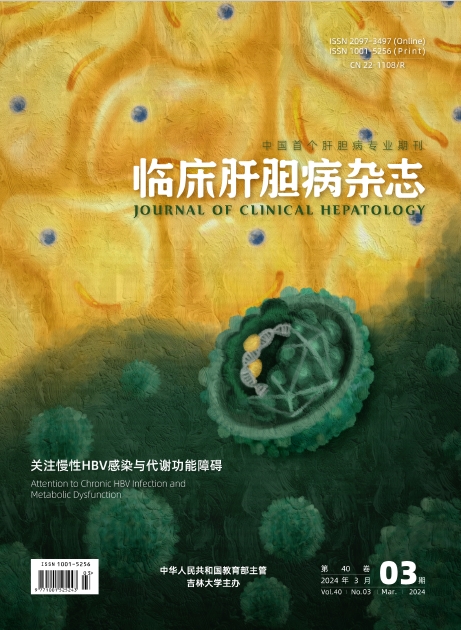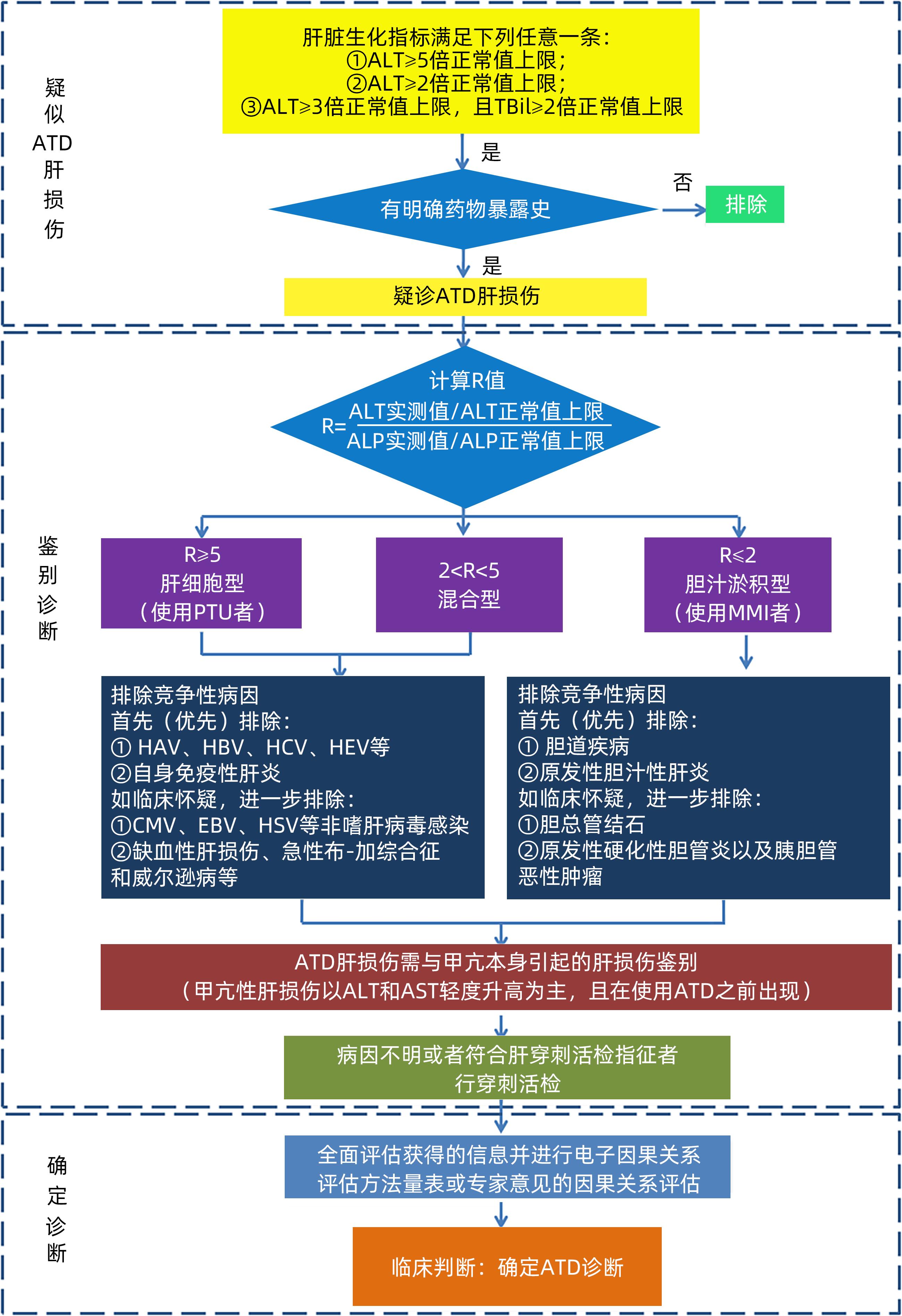| [1] |
SUZUKI N, NOH JY, HIRUMA M, et al. Analysis of antithyroid drug-induced severe liver injury in 18,558 newly diagnosed patients with Graves’ disease in Japan[J]. Thyroid, 2019, 29( 10): 1390- 1398. DOI: 10.1089/thy.2019.0045. |
| [2] |
ZENG J, LUO F, LIN Z, et al. Rash and cholestatic liver injury caused by methimazole in a woman with Turner syndrome and Graves’s disease: a case report and literature review[J]. BMC Endocr Disord, 2021, 21( 1): 179. DOI: 10.1186/s12902-021-00819-1. |
| [3] |
Technology Committee on DILI Prevention and Management, Chinese Medical Biotechnology Association; Study Group of Drug⁃Induced Liver Disease, Chinese Medical Association for the Study of Liver Diseases. Guidelines for the diagnosis and treatment of drug-induced liver injury[J].[J]. J Clin Hepatol, 2015, 31( 11): 1752- 1769. DOI: 10.3969/j.issn.1001-5256.2015.11.002. |
| [4] |
Professional Committee of Prevention and Treatment of Pharmaceutical Liver Injury of China Medical Biotechnology Association, Pharmaceutical Hepatology Group of Liver Disease Branch of Chinese Medical Association. Chinese guideline for diagnosis and management of drug-induced liver injury(2023 version)[J]. Chin J Gastroenterol, 2022, 27( 6): 341- 375. DOI: 10.3760/cma.j.cn501113-20230419-00176. |
| [5] |
YU W, WU N, LI L, et al. Side effects of PTU and MMI in the treatment of hyperthyroidism: a systematic review and meta-analysis[J]. Endocr Pract, 2020, 26( 2): 207- 217. DOI: 10.4158/EP-2019-0221. |
| [6] |
CARRION AF, CZUL F, AROSEMENA LR, et al. Propylthiouracil-induced acute liver failure: role of liver transplantation[J]. Int J Endocrinol, 2010, 2010: 910636. DOI: 10.1155/2010/910636. |
| [7] |
|
| [8] |
|
| [9] |
HEIDARI R, NIKNAHAD H, JAMSHIDZADEH A, et al. Factors affecting drug-induced liver injury: antithyroid drugs as instances[J]. Clin Mol Hepatol, 2014, 20( 3): 237- 248. DOI: 10.1155/2010/910636. |
| [10] |
MIZUTANI T, YOSHIDA K, MURAKAMI M, et al. Evidence for the involvement of N-methylthiourea, a ring cleavage metabolite, in the hepatotoxicity of methimazole in glutathione-depleted mice: structure-toxicity and metabolic studies[J]. Chem Res Toxicol, 2000, 13( 3): 170- 176. DOI: 10.1021/tx990155o. |
| [11] |
HEIDARI R, BABAEI H, EGHBAL M. Mechanisms of methimazole cytotoxicity in isolated rat hepatocytes[J]. Drug Chem Toxicol, 2013, 36( 4): 403- 411. DOI: 10.3109/01480545.2012.749272. |
| [12] |
SUN J, ZHAO F, LIN B, et al. Gut microbiota participates in antithyroid drug induced liver injury through the lipopolysaccharide related signaling pathway[J]. Front Pharmacol, 2020, 11: 598170. DOI: 10.3389/fphar.2020.598170. |
| [13] |
CLARKE JI, DEAR JW, ANTOINE DJ. Recent advances in biomarkers and therapeutic interventions for hepatic drug safety-false dawn or new horizon?[J]. Expert Opin Drug Saf, 2016, 15( 5): 625- 634. DOI: 10.1517/14740338.2016.1160057. |
| [14] |
DEAR JW, CLARKE JI, FRANCIS B, et al. Risk stratification after paracetamol overdose using mechanistic biomarkers: results from two prospective cohort studies[J]. Lancet Gastroenterol Hepatol, 2018, 3( 2): 104- 113. DOI: 10.1016/S2468-1253(17)30266-2. |
| [15] |
GALLELLI L, STALTARI O, PALLERIA C, et al. Hepatotoxicity induced by methimazole in a previously healthy patient[J]. Curr Drug Saf, 2009, 4( 3): 204- 206. DOI: 10.2174/157488609789006912. |
| [16] |
LI L, JIANG W, WANG J. Clinical analysis of 275 cases of acute drug-induced liver disease[J]. Front Med China, 2007, 1( 1): 58- 61. DOI: 10.1056/NEJMra052270. |
| [17] |
FORD R, SCHWARTZ L, DANCEY J, et al. US Food and Drug Administration. Center for Drug Evaluation and Research(CDER), Center for Biologics Evaluation and Research(CBER). Guidance for industry: drug-induced liver injury-premarketing clinical evaluation[J]. Eur J Cancer, 2009, 45( 2): 268- 274.
|
| [18] |
de ALMEIDA R, MCCALMON S, CABANDUGAMA PK. Clinical review and update on the management of thyroid storm[J]. Mo Med, 2022, 119( 4): 366- 371.
|
| [19] |
WAN YM, WU JF, LI YH, et al. Prednisone is not beneficial for the treatment of severe drug-induced liver injury: An observational study(STROBE compliant)[J]. Medicine(Baltimore), 2019, 98( 26): e15886. DOI: 10.1097/MD.0000000000015886. |
| [20] |
MA JGJ, LAMMERT C. Characterization of steroid therapy for drug-induced liver injury[J]. Gastroenterology, 2020, 158( 6): S-1304. DOI: 10.1016/S0016-5085(20)33922-6. |
| [21] |
WANG JB, HUANG A, WANG Y, et al. Corticosteroid plus glycyrrhizin therapy for chronic drug- or herb-induced liver injury achieves biochemical and histological improvements: a randomised open-label trial[J]. Aliment Pharmacol Ther, 2022, 55( 10): 1297- 1310. DOI: 10.1111/apt.16902. |
| [22] |
HEIDARI R, BABAEI H, ROSHANGAR L, et al. Effects of enzyme induction and/or glutathione depletion on methimazole-induced hepatotoxicity in mice and the protective role of N-acetylcysteine[J]. Adv Pharm Bull, 2014, 4( 1): 21- 28. DOI: 10.5681/apb.2014.004. |
| [23] |
SQUIRES RH, DHAWAN A, ALONSO E, et al. Intravenous N-acetylcysteine in pediatric patients with nonacetaminophen acute liver failure: a placebo-controlled clinical trial[J]. Hepatology, 2013, 57( 4): 1542- 1549. DOI: 10.1002/hep.26001. |
| [24] |
YANG J, ZHONG J, ZHOU LZ, et al. Sudden onset agranulocytosis and hepatotoxicity after taking methimazole[J]. Intern Med, 2012, 51( 16): 2189- 2192. DOI: 10.2169/internalmedicine.51.7845. |
| [25] |
WANG Y, WANG Z, GAO M, et al. Efficacy and safety of magnesium isoglycyrrhizinate injection in patients with acute drug-induced liver injury: A phase II trial[J]. Liver Int, 2019, 39( 11): 2102- 2111. DOI: 10.1111/liv.14204. |
| [26] |
LI WX, RAO Z, WU T, et al. Clinical effect of magnesium isoglycyrrhizinate in the treatment of drug-induced liver injury induced by methimazole[J]. Clin Ration Drug Use, 2023, 16( 16): 69- 71. DOI: 10.15887/j.cnki.13-1389/r.2023.16.019. |
| [27] |
WANG Y, LAI R, ZONG P, et al. Bicyclol for the treatment of drug-induced liver injury: a propensity score matching analysis using a nationwide inpatient database[J]. J Int Med Res, 2021, 49( 4): 3000605211005945. DOI: 10.1177/03000605211005945. |
| [28] |
TANG J, GU J, CHU N, et al. Efficacy and safety of bicyclol for treating patients with idiosyncratic acute drug-induced liver injury: A multicenter, randomized, phase II trial[J]. Liver Int, 2022, 42( 8): 1803- 1813. DOI: 10.1111/liv.15290. |
| [29] |
APAYDıN T, ELBASAN O, YAVUZ DG. Preoperative plasmapheresis experience in Graves’ disease patients with anti-thyroid drug-induced hepatotoxicity[J]. Transfus Apher Sci, 2020, 59( 5): 102826. DOI: 10.1016/j.transci.2020.102826. |
| [30] |
ZHANG Q, GUAN Y, XIANG T, et al. Combination of molecular adsorbent recirculating system and radioiodine for the treatment of concurrent hyperthyroidism and severe liver dysfunction: a retrospective cohort study[J]. Endocr Pract, 2017, 23( 2): 141- 148. DOI: 10.4158/EP161417.OR. |
| [31] |
ZHENG M, CUI S, ZHANG W, et al. Graves’ disease overlapping with chronic hepatitis B and methimazole-induced liver injury and autoimmune hepatitis: a case report[J]. BMC Gastroenterol, 2022, 22( 1): 59. DOI: 10.1186/s12876-022-02133-z. |
| [32] |
BENIĆ MS, NEŽIĆ L, VUJIĆ-ALEKSIĆ V, et al. Novel therapies for the treatment of drug-induced liver injury: a systematic review[J]. Front Pharmacol, 2021, 12: 785790. DOI: 10.3389/fphar.2021.785790. |








 DownLoad:
DownLoad: